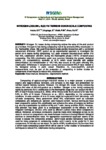Por favor, use este identificador para citar o enlazar este ítem:
http://www.alice.cnptia.embrapa.br/alice/handle/doc/1035878| Título: | Nitrogen loss (NH3, N2O) patterns in bench-scale composting. |
| Autor: | INACIO, C. T.  URQUIAGA, S.   CHALK, P. M.   ALVES, B. J. R.   |
| Afiliación: | CAIO DE TEVES INACIO, CNPS; SEGUNDO SACRAMENTO U CABALLERO, CNPAB; P. M. CHALK; BRUNO JOSE RODRIGUES ALVES, CNPAB. |
| Año: | 2015 |
| Referencia: | In: SIMPÓSIO INTERNACIONAL SOBRE GERENCIAMENTO DE RESÍDUOS AGROPECUÁRIOS E AGROINDUSTRIAIS, 4., 2015, Rio de Janeiro. Anais... Brasília, DF: Embrapa, 2015. |
| Descripción: | Nitrogen (N) losses during composting reduce the value of the end product as a fertilizer. Nitrogen is lost during composting mainly by ammonia (NH3) volatilization in the thermophilic phase. We used three bench-scale aerobic bioreactors with a controlled temperature difference (CDT) system as an experimental approach to investigate the pattern of N losses during composting. N2O peak emission occurred much earlier (7h) than NH3 volatilization (48-60h) during the thermophilic phase (~55°C) of bench-scale composting. The NH3 volatilization peak rate occurred following the greater biological activity (O2 consumed/CO2 evolved) at 40°C which could coincide with greater ammonification, but immobilization of NH4+/NH3 also occurs at this point affecting NH3 volatilization. Differences in temperature curves and accumulated NH3-N were related to the biological activity in each vessel. Therefore, O2 consumed/CO2 evolved measurements must be part of the evaluation of composting in further studies for comparisons of techniques to reduce NH3 volatilization |
| Palabras clave: | Estrume de cavalo Biorreatores Método respirométrico |
| Tipo de Material: | Artigo em anais e proceedings |
| Acceso: | openAccess |
| Aparece en las colecciones: | Artigo em anais de congresso (CNPS)  |
Ficheros en este ítem:
| Fichero | Descripción | Tamaño | Formato | |
|---|---|---|---|---|
| 2015158.pdf | 184,11 kB | Adobe PDF |  Visualizar/Abrir |









